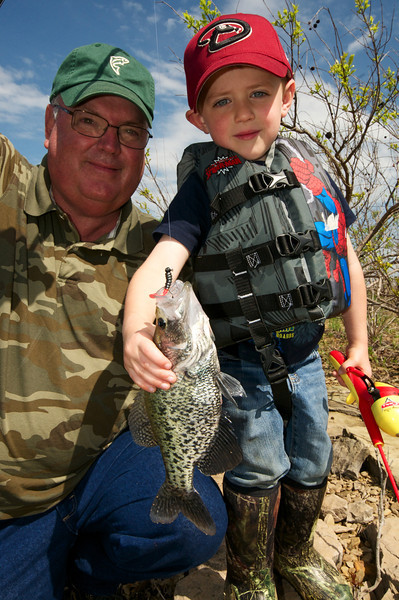Fishing Tips
Stocking crappie in ponds is not recommended, but they are good to eat and some people want them anyway. Trophy crappie fishing is available in farm ponds, as evidenced by the fact that the state record catches of both crappie species are from ponds. However, good crappie fishing in ponds is usually a short-term occurrence. Typically the fishery is supported by a few large individuals stocked as adults or by the initial spawn from stocked adults. In most instances, stocking crappie in ponds results in an overcrowded crappie population and overall poor fishing for all species. Crappie have a tendency to produce sporadic and sometimes extremely abundant year classes. If the pond lacks sufficient bass to reduce the numbers of young crappie, they quickly overpopulate and become stunted or slow-growing. This situation is difficult to remedy; the best solution is to renovate the pond with rotenone or drain and restock at recommended stocking rates.
A pond with stunted crappie can be stocked with about 50 10- to 12-inch bass per acre from a commercial hatchery. Ideally, stocked bass should be at least three times as long as the average size of the stunted crappie, but almost any length bass over 12 inches will eventually help the situation. It is very expensive to stock enough large bass to control an existing stunted crappie pond. If you decide to transfer bass from another pond, be sure to follow legal fishing techniques and possession limits.
If a significant bass population still exists in a pond with stunted crappie, one or more annual drawdowns may reduce crappie numbers and subsequently increase their size. The pond should be drawn down to less than half the normal surface area while maintaining some water at least seven feet deep during the drawdown phase. Each drawdown should last at least six months. No bass harvest should occur during the drawdown. This method can be the least expensive option if a drawdown structure exists in the pond. However, it can be a relatively expensive method when water has to be pumped out or the dam has to be cut and then repaired. Management success of drawdowns probably is lower than for other options.

Some ponds continue to produce quality crappie fishing, and it is possible to manage a pond for crappie. However, we recommend that you stock them in your pond only if you are specifically interested in managing your pond for crappie.
If you are going to stock crappie in a pond, it is highly recommended that you stock black crappie or a hybrid cross of black and white crappie. Black crappie generally do not overpopulate and stunt to the degree white crappie do, and therefore they generally exhibit superior growth. Black crappie also are somewhat more tolerant of handling than white crappie, which improves stocking success. The two species can be identified by counting the stiff spines in the dorsal (top) fin. Black crappie have seven to eight dorsal spines, whereas white crappie generally have six.
The key to maintaining a “quality” crappie population in a pond is having a crowded bass population. Therefore, if your primary intent is to produce quality bass fishing, stocking crappie is not recommended.
A crappie pond should be at least two acres in size, be relatively clear and have aquatic vegetation covering about 20 percent of the surface. The bass population must be able to reproduce well each year.
If the pond provides satisfactory angling and already contains crappie, the key to success is effective bass predation on smaller crappie. A 15-inch minimum bass length limit should be imposed until crappie numbers are reduced.